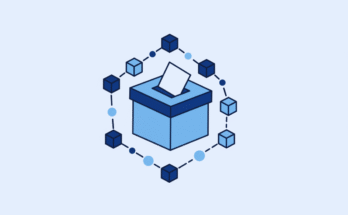Blockchain technology enables trust, transparency and traceability across decentralized networks, creating new models of cooperation and collaboration between businesses. Security remains of the utmost importance to blockchain projects, with initiatives like Zero-Knowledge Proofs (ZKPs) and quantum-resistant encryption providing added layers of protection.

1. Blockchain as a Service (BaaS)
BaaS offers businesses an alternative to in-house blockchain systems that requires substantial upfront investments of hardware and software; BaaS allows businesses to adopt blockchain technology with minimal investments. Much like web hosting providers host websites for clients rather than themselves, using BaaS allows companies to utilize third-party providers who will take care of backend infrastructure maintenance while they focus on building their applications.
BaaS platforms provide an affordable way for organizations across industries to leverage blockchain. Their flexible and scalable model can serve as the catalyst for greater blockchain adoption across sectors, and their prebuilt tools and functionalities help reduce development times to quickly launch blockchain applications with relative ease.
Implementing smart contracts on a blockchain can facilitate rapid deployment and scaling for businesses that prioritize fast deployment and scalability, such as streamlining supply chain management processes and cutting costs by automating transactions. Furthermore, this approach allows secure identity verification for improved security and transparency within an organisation.
2. Artificial Intelligence (AI)
Artificial Intelligence (AI) and blockchain are complementary technologies, each possessing unique strengths. AI can assist with analyzing and managing business network data while blockchain enables secure transactions and transparent supply chains.
This convergence of technologies offers many advantages for creative content creators and music and film licensing, and non-fungible tokens (NFTs) which allow owners to retain ownership while monetizing assets. Blockchain also provides security and transparency for financial services by creating instant cross-border transfers with instantaneous payments and instant cross-border transfers.
Blockchain-enabled smart contracts provide an efficient means for data integrity to be protected while also limiting which actions are possible, thus minimizing vulnerabilities. As a result, this new technology could revolutionize industries from within.
3. Decentralized Finance (DeFi)
Decentralized Finance (DeFi) is an emerging subfield within blockchain that holds promise to offer greater financial inclusion and efficiency. DeFi relies on blockchain technology which records information in blocks linked together using cryptographic principles into chains to form a distributed ledger of transactions between peers. DeFi apps and protocols are built upon blockchains, providing transparency and security while eliminating middlemen and lowering service fees to ultimately bring down consumer costs.
DeFi is revolutionizing industries such as banking, finance, insurance and supply chain finance. A blockchain app like Uniswap lets you trade assets without broker or bank fees; while Ethereum-based products like no-loss audited savings lottery and Compound money market protocol allow users to earn interest on cryptocurrency assets.
4. Tokenizing Real-World Assets (RWA)
Real-world assets like real estate, art, and commodities are increasingly tokenized on blockchain networks to bring traditional finance together with digital assets, creating opportunities for investors in both worlds.
RWA tokenization’s primary advantage lies in cost reduction and time efficiency. Asset owners can now manage their assets directly, cutting legal fees in half. Furthermore, by listing unique non-fungible assets on dedicated marketplaces they can increase liquidity for them and add liquidity for unique non-fungible assets that would otherwise remain non-liquid assets.
The tokenization of real-world assets has already had an enormous impact on major industries like real estate, commodities, and stocks. This trend will only accelerate by 2025 as more major institutions enter this space and improve regulatory clarity, fueling further rise of stablecoins such as DeFi and blockchain-based RWA tokens, also opening up possibilities of tokenizing other forms of assets including intellectual property rights or renewable energy credits.
5. Central Bank Digital Currencies (CBDC)
As CBDCs evolve, they will be used to improve payment systems, provide new financial products and services, promote financial inclusion and reduce transaction costs for businesses and consumers. They may even offer greater security than credit cards.
Many countries are exploring CBDCs. Jamaica’s JAM-DEX and China’s e-CNY use blockchain technology, while others opt for more centralized systems. No matter their implementation method, CBDCs are poised to revolutionize the future of money by combining innovation and stability in one platform, revolutionizing transactions by significantly speeding them up while decreasing transaction costs (by eliminating credit card fees for instance) which helps small businesses increase profit margins while making international money transfers more cost effective for migrants.
6. Layer 2 Solutions
Due to scalability limitations, blockchain networks can experience slow transaction speeds and high fees that adversely impact user experience and diminish practical applications built with blockchain technologies. In response to these challenges, various Layer 2 solutions have been devised to increase transaction speeds and costs on blockchain networks. Examples include Lightning Network, Optimistic Rollups and zk-Rollups.
These solutions enable Ethereum and Bitcoin networks to process many more transactions without compromising security or decentralization, as well as reduce transaction costs, making blockchain technology more accessible and affordable to more users and businesses. An effect which should lead to further adoption and ecosystem growth by 2025.
7. Metaverse Applications
The future of blockchain technology lies within the Metaverse. Combining virtual reality (VR) and augmented reality (AR), this world allows us to interact with one another, play games, learn and earn money, buy/sell digital assets and more. It truly transforms daily lives!
Blockchain plays an integral part of the Metaverse, particularly for NFTs and financial systems. Blockchain’s inherent characteristics make smart contracts in the Metaverse automated, programmable, transparent and verifiable. Eliminating harmful behaviors such as rent-seeking, corruption or underhand transactions that otherwise might exist in its presence.
Gaming Metaverse provides gamers with an exciting new way to enjoy their favorite games without worrying about slow internet connectivity or expensive hardware costs. This could have an enormously positive effect on eSports and gaming industry alike.



![[Tesla Stock vs. Bitcoin] Which One Leads the Market in 2025?](https://mineatech.com/wp-content/uploads/2025/06/tesla-stock-vs-bitcoin-which-one-leads-the-market-in-2025-348x215.png)